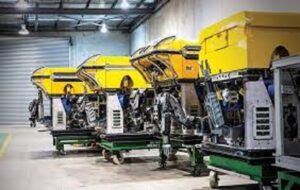Guiding the depths of innovation, Total Marine Technology (TMT) isn’t just another name in the marine initiative; it’s a beacon of cutting-edge answers and relentless dedication to distinction. With a personal touch, TMT is more than a company; it’s a partner in investigating the wonders of the deep sea. TMT’s impact is felt in every ocean ripple, from state-of-the-art ROVs to groundbreaking electric torque technology. Join us as we dive into a world of marine innovation where TMT is leading the way, shaping the future of underwater exploration.
Definition of Total Marine Technology (TMT)
Total Marine Technology, commonly referred to as TMT, is a pioneering force in the marine industry focused on transforming how we navigate and operate in the depths of our oceans. TMT represents a holistic approach to the maritime sector, offering various cutting-edge technologies, services, and solutions. From remotely operated vehicles (ROVs) to electric torque innovations and lock lot systems, TMT has emerged as a game-changer, pushing the boundaries of what is possible in marine operations. This blog will delve into the world of TMT and explore the revolutionary technologies and services that have made them a front-runner in the maritime industry.
The Role of TMT in the Marine Industry
The marine industry is a vast and multifaceted realm surrounding different sectors, including offshore energy, subsea investigation, and maritime logistics. Innovation enhances efficiency, protection, and environmental sustainability in this dynamic industry. This is where Total Marine Technology plays a pivotal role. TMT catalyzes change in the marine industry, driving innovation and progress.
TMT is not limited to a singular focus; it offers a broad spectrum of services and technologies that address the diverse needs of the marine sector. TMT’s influence reaches far and wide, from underwater robotics and healthy capping solutions to lock lot systems and ROV manipulator arms. Their commitment to innovation and problem-solving has earned them a reputation as a worldwide trusted partner for marine operations.
What is an ROV, and How Does it Work?
Remotely Operated Vehicles, or ROVs, are robotic submarines for a wide range of underwater operations. ROVs are prepared to withstand the immense anxiety and harsh conditions of the deep sea, permitting them to perform tasks that would be otherwise difficult or impossible for humans. These vehicles are provided with cameras, sensors, and manipulator arms, controlled remotely by operators on the surface.
ROVs are crucial in various industries, including offshore oil and gas exploration, deep-sea research, salvage operations, and marine construction. They provide real-time access to underwater environments, capturing high-definition video and data and executing precise tasks with their manipulator arms.
TMT’s Expertise as an ROV Manufacturer
Total Marine Technology has carved a niche for itself in the world of ROVs. As a manufacturer of cutting-edge ROV systems, TMT has a long history of pushing the envelope regarding technology and design. Their ROVs are engineered for exceptional performance, durability, and ease of operation.
TMT’s ROVs have advanced navigation and positioning systems, high-resolution cameras, and robust manipulator arms. These features allow them to excel in underwater inspections, maintenance, and intervention tasks. TMT’s rov contractors are relied upon by organizations in the offshore energy sector, marine research institutions, and various other industries.
Applications of ROVs in the Marine Industry
ROVs find applications across the marine industry, playing a pivotal role in various operations:
- Offshore Energy:
ROVs are essential for maintaining and repairing underwater infrastructure, such as oil and gas rigs. They inspect pipelines, perform subsea equipment maintenance, and assist in healthy intervention operations.
- Scientific Research:
Researchers use ROVs to explore the mysteries of the deep ocean. They collect samples, document marine life, and investigate geological formations, contributing to our understanding of the underwater world.
- Salvage and Recovery:
In cases of shipwrecks or lost cargo, ROVs are deployed to assess the situation, retrieve valuable assets, and mitigate environmental damage.
- Marine Construction:
ROVs assist in installing and maintaining underwater structures, such as underwater cables and pipelines. Their precision and agility are crucial for these tasks.
- Environmental Assessment:
ROVs are used to monitor and evaluate the condition of marine ecosystems and underwater environments. This data is vital for ensuring environmental protection and sustainability.
Total Marine Technology’s ROVs are at the forefront of these applications, delivering state-of-the-art technology and expertise to enhance marine operations.
The Importance of Digger Intervention in Marine Operations
Digger intervention refers to the act of intervening in underwater operations, mainly when there is a need to excavate, manipulate, or address challenges beneath the surface. This process is integral in marine operations, such as offshore construction, maintenance, and well interventions. Proper digger intervention ensures that tasks are completed efficiently and safely.
TMT’s Solutions for Effective Digger Intervention
Total Marine Technology has become a leader in providing digger intervention solutions. Their expertise in this area is instrumental in addressing complex challenges during marine operations. TMT’s digger intervention total marine solutions encompass various technologies and equipment, including remotely operated vehicles with advanced manipulator arms and specialized tools.
These solutions handle tasks such as clearing debris, trenching, excavating, and placing underwater structures. TMT’s commitment to safety and efficiency has made them a sought-after partner for projects that require digger intervention.
Exploring Electric Torque and Its Significance
Electric torque is a fundamental concept in electromagnetism and is essential in various applications, particularly in electrical machines and devices. It refers to the rotational force or moment produced when an electric current flows through a conductor in a magnetic field. Understanding electric torque and its significance is crucial for designing and operating various electrical and electromechanical systems.
Key Points Regarding Electric Torque:
Basic Principle:
Electric torque is generated when an electric current passes through a conductor placed within a magnetic field. The interaction between the magnetic field and the current induces a force that causes the conductor to rotate.
Magnetic Field Strength:
The strength of the magnetic field and the current passing through the conductor are the primary factors influencing the magnitude of electric torque. Increasing either of these variables will generally result in higher torque.
Right-Hand Rule:
The right-hand rule determines the direction of the electric torque. If you point your thumb in the direction of the current and curl your fingers, the order in which your fingers curl represents the direction of the torque.
Applications:
Electric Motors: Electric motors are one of the most common applications of electric torque. In these devices, an electric current is supplied to a coil of wire placed within a magnetic field, causing the ring to rotate and produce mechanical work. Electric motors power various devices, from household appliances to industrial machinery.
Generators:
Mechanical torque rotates a coil within a magnetic field, producing an electric current. This is the reverse process of what happens in an electric motor.
Actuators:
Electric torque is used in rov actuator to control the movement of various components, such as valves and control surfaces in aircraft or robots.
Electric Vehicles:
However, electric vehicles (EVs) use electric motors to convert electrical energy from the battery into mechanical torque to drive the car. The torque generated by the engine propels the wheels.
Efficiency and Control:
Understanding electric torque is crucial for optimizing the efficiency of electric machines. By adjusting the magnitude and direction of the current, as well as the properties of the magnetic field, the torque can be controlled and regulated to meet specific performance requirements.
Significance in Renewable Energy:
Electric torque plays a vital role in renewable energy systems, such as wind turbines and hydroelectric generators. These systems convert the kinetic energy of wind or water into mechanical torque, which is then converted into electrical energy.
Torsional Load:
Electric torque is essential when assessing the mechanical integrity of rotating systems, as it determines the mechanical stress and wear on components like shafts and bearings.
Safety Considerations:
High torque can pose safety risks in electrical machines, as it can cause unexpected movements or failures. Proper design and control mechanisms are crucial to ensure safe operation.
The Rigmaster: A Breakthrough in Electric Torque Technology
Total Marine Technology’s Rigmaster is a revolutionary electric torque tool designed to meet the demanding requirements of marine operations. The Rigmaster offers unparalleled torque accuracy, repeatability, and control, making it an essential component in subsea systems.
The Rigmaster’s precision is crucial for wellhead installation and maintenance, ensuring secure and leak-free connections. Its state-of-the-art design and engineering have set new standards in the industry, enhancing safety and operational efficiency.
In addition to the Rigmaster, Total Marine Technology has introduced the Stab 6, an innovative subsea connector system. The Stab 6 offers rapid and secure connection capabilities, reducing downtime during marine operations. It is compatible with various marine rov, making it a versatile choice for underwater applications.
Frequently Asked Questions (FAQs)
- What are the examples of marine technology?
Marine technology includes remotely operated vehicles (ROVs), underwater sensors, sonar systems, subsea communication equipment, navigation systems, and environmentally friendly marine propulsion technologies.
- What is the meaning of marine technology?
Marine technology refers to applying scientific and engineering principles to develop solutions and tools for various marine-related activities. It encompasses multiple technologies in exploration, navigation, research, and offshore operations in the world’s oceans and seas.
- What is the revenue of Total Marine Technology?
As of my last knowledge update in September 2021, I need access to real-time financial data. To obtain the current revenue of Total Marine Technology, I recommend visiting their official website or referring to recent financial reports and publications.
- What is the introduction of marine technology?
Introducing marine technology involves presenting and explaining the fundamental concepts, advancements, and innovations in the technology field as applied to aquatic environments. It covers technology’s history, significance, and impact on marine-related industries and activities, such as marine transportation, exploration, research, and resource extraction.
- What can I use as a temporary oil cap?
A plastic bag and a rubber band or tape can serve as a makeshift oil cap in an emergency.
Wrap It Up
In the boundless expanse of the seas, Total Marine Technology (TMT) is more than a beacon; it’s a companion on your voyage. Our commitment to innovation and unwavering dedication to your marine needs make us not just a company but a trusted partner. We set sail on this journey together with a shared vision of a safer, more efficient marine industry. As the waves of technology evolve, TMT remains your constant, guiding you through the depths. Let’s navigate the future of marine technology together, creating a world where the oceans reveal their mysteries and possibilities are limitless.




[…] building a mind-resilient future, we stand at a crossroads where technological innovation meets the preservation of our core human values. By embracing the ethical implication of mind […]
[…] as worries about security and privacy. It is becoming increasingly vital that we comprehend these technologies’ workings and the threats they pose as we navigate the digital realm. The world of access technologies is constantly changing. Therefore, we must […]
[…] like having a personal plant whisperer guiding us to nurture each leaf and petal carefully. This innovative blend of nature and technology isn’t just about greenery; it’s about cultivating a deeper connection with the world […]
[…] conference covers various topics, including cybersecurity trends, threat mitigation, technology innovations, data privacy, AI and machine learning, cryptography, ethical hacking, and […]
[…] Technologies offers a range of career opportunities for individuals who share their passion for technology and innovation. From software engineers and data scientists to project managers and designers, the company […]
[…] women in the digital era, equipping them with the skills to navigate technology […]
Thank you for your sharing. I am worried that I lack creative ideas. It is your article that makes me full of hope. Thank you. But, I have a question, can you help me?